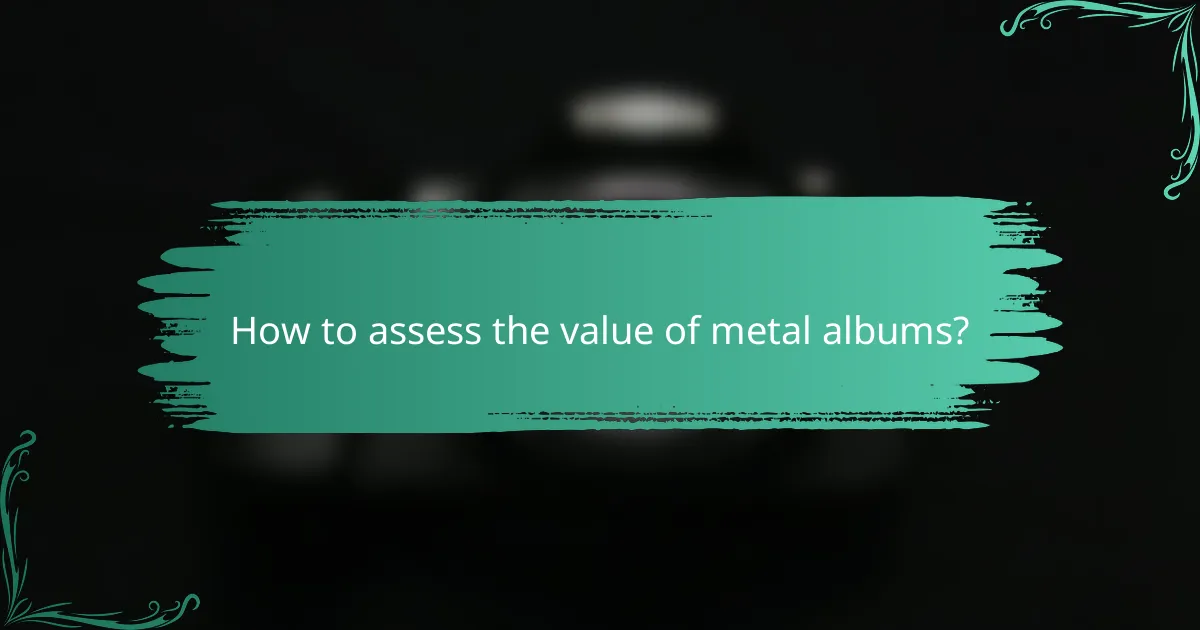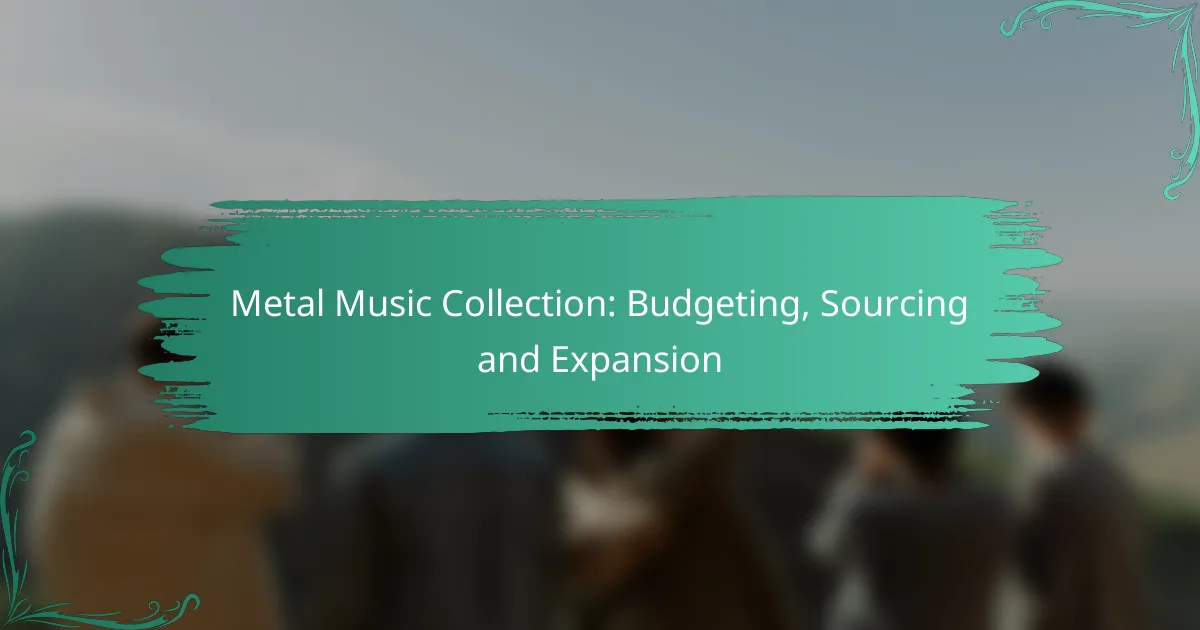Building a metal music collection requires careful budgeting, strategic sourcing, and a keen eye for expansion opportunities. By setting spending limits and prioritizing key albums, collectors can create a diverse library without breaking the bank. Various platforms, from local record stores to online marketplaces, offer unique avenues to discover both new and rare finds, ensuring that every metal enthusiast can enhance their collection effectively.

How to budget for a metal music collection?
Budgeting for a metal music collection involves setting limits on spending, prioritizing key albums, and tracking expenses. By being strategic about your purchases, you can build a diverse collection without overspending.
Set a monthly spending limit
Establishing a monthly spending limit is crucial for maintaining control over your budget. Consider allocating a specific amount, such as $30 to $50, depending on your financial situation and collection goals. This limit helps prevent impulse buys and ensures you can enjoy your hobby sustainably.
Adjust your limit as needed based on your income and other financial obligations. If you find a rare album, you might temporarily increase your budget for that month, but be sure to compensate in subsequent months.
Prioritize essential albums
Identify essential albums that are foundational to your metal music collection. Focus on iconic releases from influential bands or genres that resonate with you. For instance, albums like Metallica’s “Master of Puppets” or Iron Maiden’s “The Number of the Beast” are often considered must-haves.
Make a list of albums you want to acquire and rank them based on importance. This prioritization helps you allocate your budget effectively, ensuring you invest in the most significant additions first.
Utilize budgeting apps
Budgeting apps can simplify tracking your spending and managing your music collection budget. Apps like Mint or YNAB (You Need A Budget) allow you to set spending limits, categorize expenses, and monitor your financial progress in real-time.
Choose an app that aligns with your needs, and regularly update it with your music purchases. This practice will help you stay accountable and make informed decisions about future acquisitions.
Track expenses regularly
Regularly tracking your expenses is essential for effective budgeting. Keep a log of all your music purchases, noting the date, amount spent, and the album acquired. This habit helps you see where your money is going and adjust your spending habits accordingly.
Consider reviewing your expenses at the end of each month to assess your budget’s effectiveness. If you find you consistently overspend, it may be time to reevaluate your priorities or adjust your monthly limit.

Where to source metal music albums?
Sourcing metal music albums can be done through various avenues, each offering unique benefits. Local record stores, online marketplaces, vinyl fairs, and streaming services all provide opportunities to find both new and rare albums.
Local record stores
Local record stores are a great starting point for sourcing metal music albums. They often carry a curated selection of new releases and classic titles, allowing you to discover local bands and hidden gems. Visiting these stores also supports small businesses and fosters a sense of community among music lovers.
When shopping at local stores, check for special promotions or events, such as in-store performances or sales on vinyl. Building a relationship with store staff can also lead to insider tips on upcoming releases or exclusive items.
Online marketplaces like Discogs
Online marketplaces, particularly Discogs, are excellent for sourcing both new and used metal albums. Discogs features a vast database of music, allowing you to find specific albums, compare prices, and read reviews from other collectors. This platform is especially useful for locating rare pressings or out-of-print records.
When using online marketplaces, be sure to check seller ratings and shipping costs. It’s advisable to set a budget for your purchases, as prices can vary widely based on condition and rarity.
Vinyl fairs and conventions
Vinyl fairs and conventions are fantastic events for sourcing metal music albums in a vibrant atmosphere. These gatherings often feature numerous vendors, allowing you to browse a diverse selection of records and meet fellow enthusiasts. You can often find exclusive releases or limited editions at these events.
To make the most of vinyl fairs, arrive early for the best selection and bring cash for quicker transactions. Networking with other collectors can also lead to valuable recommendations and potential trades.
Streaming services for discovery
Streaming services play a crucial role in discovering new metal music albums. Platforms like Spotify, Apple Music, and YouTube Music offer curated playlists and recommendations based on your listening habits. This can help you explore subgenres and find artists you might not encounter otherwise.
Utilize features like “Discover Weekly” or “Release Radar” to stay updated on new music. While streaming services are not a source for physical albums, they can guide your purchasing decisions by highlighting what to look for in local stores or online marketplaces.

What are the best platforms for expanding a metal music collection?
The best platforms for expanding a metal music collection include Bandcamp, eBay, Amazon, and various Facebook groups. Each platform offers unique benefits, catering to different needs such as discovering independent artists, finding rare albums, purchasing new releases, or connecting with fellow collectors.
Bandcamp for independent artists
Bandcamp is a premier platform for discovering and supporting independent metal artists. It allows users to purchase music directly from the artists, often providing options for digital downloads, vinyl, and merchandise.
When using Bandcamp, explore the “Discover” section to find new releases and curated playlists. Many artists offer exclusive content, so consider following your favorites for updates on new music and special offers.
eBay for rare finds
eBay is an excellent resource for sourcing rare and collectible metal albums. You can find everything from vintage vinyl to out-of-print CDs, often at competitive prices.
To maximize your chances of finding what you want, use specific search terms and set alerts for items of interest. Be cautious of seller ratings and descriptions to avoid counterfeit products or misrepresented conditions.
Amazon for new releases
Amazon is a reliable platform for purchasing new metal releases, often featuring a wide selection of both physical and digital formats. You can easily compare prices and read customer reviews to make informed decisions.
Utilize Amazon’s pre-order options to secure upcoming albums and take advantage of deals on bundled items. Keep an eye on the “Amazon Music” section for exclusive releases and discounts.
Facebook groups for collectors
Facebook groups dedicated to metal music collectors provide a community for sharing information, trading, and buying or selling albums. These groups often feature members who are passionate about specific genres or bands, making them valuable resources.
When joining these groups, engage respectfully and follow the group’s rules. Look for posts about sales or trades, and consider posting your own collection to attract potential buyers or trade partners.

How to assess the value of metal albums?
To assess the value of metal albums, consider factors such as rarity, condition, and market demand. Understanding these elements will help you determine a fair price when buying or selling albums.
Check discography and rarity
Start by examining the discography of the artist to identify limited editions, special releases, or albums that are no longer in print. Rarity significantly impacts value; albums with fewer copies available tend to be more sought after.
For example, a first pressing of a classic metal album may be worth considerably more than a later reissue. Utilize resources like collector guides or online databases to verify the rarity of specific albums.
Review condition and grading
The condition of an album is crucial in determining its value. Grading systems, such as the Goldmine Standard, categorize albums from Mint (M) to Poor (P), affecting pricing. A well-maintained album in Near Mint (NM) condition can fetch a higher price than one rated Good (G).
Inspect both the vinyl and the cover for scratches, warps, or wear. A simple checklist for grading includes checking for surface noise, label condition, and sleeve integrity.
Compare prices on multiple platforms
To get an accurate sense of an album’s market value, compare prices across various platforms like Discogs, eBay, and local record shops. Prices can vary widely based on seller reputation, location, and demand.
Keep an eye on completed sales to see what similar albums have sold for recently. This will provide a realistic benchmark for pricing your own albums or making a purchase.

What are the criteria for selecting albums?
When selecting albums for a metal music collection, consider genre preferences, artist popularity, and reviews. These criteria help ensure a diverse and appealing collection that reflects personal taste and critical acclaim.
Genre and subgenre preferences
Identifying your preferred genres and subgenres is crucial in building a cohesive metal collection. Metal encompasses a variety of styles, including heavy metal, thrash, black, and death metal, among others. Focus on the subgenres that resonate most with you to create a collection that you will enjoy and appreciate.
To explore different genres, listen to playlists or radio stations dedicated to specific styles. This can help you discover new artists and albums that align with your tastes. Aim for a balanced mix of well-known and underground bands to enrich your collection.
Artist popularity and influence
Considering artist popularity and influence can guide your selection process. Popular artists often have a significant impact on the metal scene, shaping trends and inspiring new musicians. Including influential albums can provide context and depth to your collection.
Research artists’ histories and contributions to the genre. Look for albums that have received accolades or have been pivotal in defining metal music. This can enhance your understanding of the genre’s evolution and its key players.
Reviews and ratings
Reviews and ratings from credible sources can help you assess the quality of albums. Websites, magazines, and music forums often provide insights into the strengths and weaknesses of specific releases. Pay attention to both critic and user reviews to get a well-rounded perspective.
When evaluating reviews, consider the overall consensus rather than individual opinions. Albums with consistently high ratings across multiple platforms are likely to be worth adding to your collection. However, don’t shy away from albums with mixed reviews; personal taste plays a significant role in what you may enjoy.
